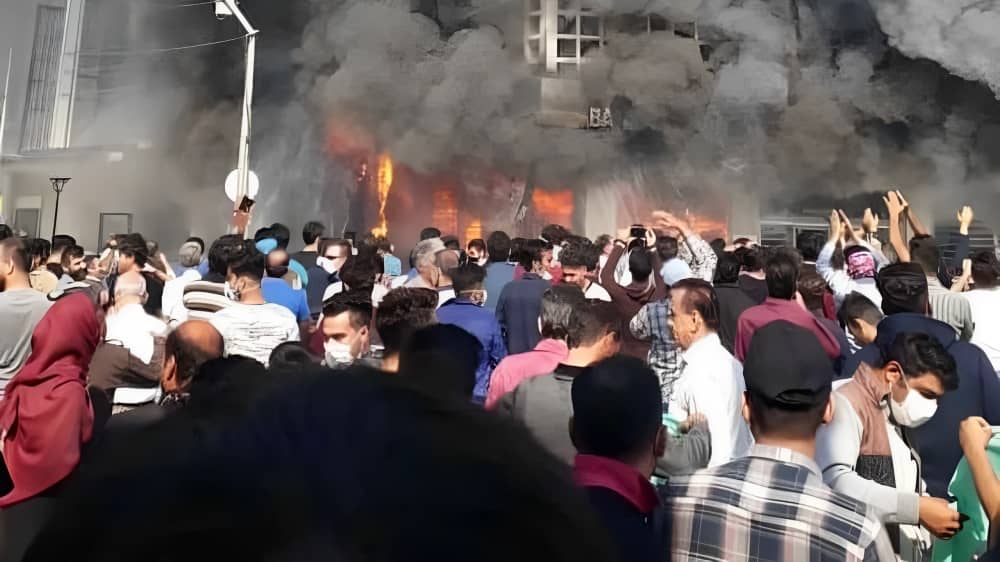When the flames of the November 2019 uprising ignited and waved across hundreds of cities all over Iran, the clerical dictatorship initially sought to downplay it as “the emotional reaction of a group of misled young people.” Subsequently, efforts were made to associate some of these youths “with foreign powers,” implying that others had unwittingly fallen into their influence. Next, state-sanctioned propaganda and the consistent narrative from so-called experts on state-controlled media aimed to portray the uprising as a natural consequence of economic problems while concealing any underlying political grievances.
On Friday night of November 15, 2019, following months of contradictory reports on the potential and denial of fuel price increases across Iran, the official announcement came obviously on a weekend, with fuel prices tripling. The following day witnessed widespread protests as people took to the streets in 21 cities, sparking fiery demonstrations that spread to hundreds of towns and villages. Thousands of fuel stations, banks, municipal buildings, centers of security forces, and even police vehicles were completely burned down.
Struggling for comprehension
After the huge shock that shook the very foundations of the entire regime, officials and affiliated experts at different levels sought to offer explanations for the evolving situation. Their aim was to draw conclusions that could shed light on the root causes, with the hope of preventing similar incidents in the future.
In December 2019, Iranian state media published reports about a meeting where Amir Mohabian, a theorist associated with the ruling faction, expressed his perspective: “I maintain the belief that we should brace ourselves for a more severe scenario [in the future]. The proximity of these protests suggests a converging trajectory.”
He further warned, “The outburst of anger and resentment defines these protests. A distinct and intense anger manifested, freeing itself and is now remembered as the rise of an aggrieved class.”
5)
Iran: 2019 Uprising, Names of Victims of November 2019 Protests Crackdown in #Iran #WeStand4FreeIranhttps://t.co/YatNPzHMkV pic.twitter.com/n2L9Bq4bsf— NCRI-FAC (@iran_policy) November 1, 2020
Rahim Abolhasani, reportedly a university professor and a member of the faction that introduces itself as being “reformists”, told the Fararu website on December 15, 2019, “Since 2017, we’ve entered a new phase. Starting in 2017, the disgruntled and the economically disadvantaged have taken center stage, leading to uprisings by the discontented and hungry. Consequently, in 2017, we witnessed protests erupting in over 80 cities, predominantly non-political, expressing clear and focused grievances. These protests have a definite direction. Firstly, they target economic centers. Secondly, the discontented turn their attention to political, cultural, and urban institutions such as religious seminaries, governor offices, and municipalities. Among these governmental entities, the municipality stands out as the least trusted, possessing the lowest social capital, and is regarded as the most notorious institution.”
However, despite attempting to understand the concerns of the restless society through numerous events and a multitude of articles and essays, the regime has been unsuccessful in addressing the underlying issue—the regime itself.
Underlying factors for revolt
In the November 2019 uprising, Shiraz took center stage as a significant flashpoint, marked by widespread protests and the passionate involvement of rebellious youth. The city’s unique circumstances offer nuanced insights that can aid in comprehending future events in other Iranian cities.
In November 2018, the semi-official news agency ISNA reported that the suburban areas surrounding Shiraz, covering 1,400 hectares, are home to approximately 18,400 households. The source noted that these residents face challenging living conditions, exacerbated by the unauthorized tapping into water and electricity connections, resulting in undesirable landscapes.
Video Messages of Defiant Women and Resistance Units Nationwide #Iran #MEK https://t.co/h6bjKOG1bs pic.twitter.com/kRNB65iuZG
— NCRI-FAC (@iran_policy) October 24, 2021
On October 24, 2020, one year post-uprising, Tasnim News Agency, affiliated with the IRGC, emphasized the poverty issue in Shiraz’s villages and suburbs. Major cities, including Shiraz, grapple with challenges due to suburban development, driven by migration from villages to larger cities, primarily due to unemployment. Consecutive droughts further contribute to rural-to-urban migration. Tasnim highlighted 40 villages near Shiraz lacking infrastructure, with over 60% of the population entrenched in poverty. Rising inflation and rental costs continue to drive people toward these impoverished areas.
According to the regime’s own publicly disclosed statistics and information, the radicalization of the uprising and the people’s movement in major cities like Shiraz stemmed from numerous unaddressed demands of the marginalized sections of society. Despite all this, the regime strongly believes that an organized minority possessing fire superiority can always crack down on the hungry masses. This conviction leads the regime to disregard the grievances of the people, diverting resources to its detrimental agenda.
But another critical oversight by the regime prior to the 2019 uprising was its failure to recognize the depth of the Iranian Resistance’s network within the country. The extensive demonization campaign against the Mujahedin-e Khalq Organization (MEK/PMOI) both inside and outside Iran, along with terror plots targeting their members and supporters, as well as the political pressure exerted by Tehran on the West to outlaw the organization, indicates the regime’s profound fear of what it deems it Achilles Heels.



